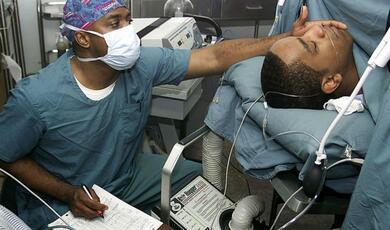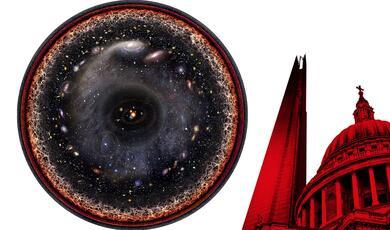Microbial Megastructures
Share
- Details
- Text
- Audio
- Downloads
- Extra Reading
*Please note that due to industrial action this lecture was rescheduled to the new date of 29 November 2022.
Invisible microbes have created some of the largest structures on the planet. Mycorrhizal fungi form extraordinary subterranean networks that associate symbiotically with plant roots. Most land plants, including many human crops, need mycorrhizae for optimal growth, but recent research has shown they also play important roles in forest-wide communication and may even turn some trees into carnivores. More dramatically, microbial communities have created global landmarks ranging from the White Cliffs of Dover to the Great Barrier reef.
Download Text
Microbial Megastructures
Professor Robin May
29th November 2022
Microbes are, by definition, well…microscopic. They cannot be seen with the naked eye and often their very existence passes us by unnoticed. But occasionally, the combined activity of billions of microbes can create structures that exceed anything created by human beings. In this lecture we are going to examine remarkable feats of microbial engineering, from miniscule nanomachines to gargantuan megastructures.
Microbial Machines
Under a microscope, the varying shapes and sizes of microbes can be dizzying. A typical single-celled amoeba is thousands of times bigger than a typical bacterium, which in turn is thousands of times larger than a typical virus. But even at this tiny scale, precision structures that are more elaborate than anything created by humans abound. Bacteria, fungi and algae are encased within a rigid cell wall which is often covered in a complex chemical capsule. These structures have features that humans have thus far never managed to replicate; rigid but permeable, flexible but durable, capable of being dramatically remodelled within minutes yet resisting the effects of weathering for millennia. Understanding how microbes achieve this may offer opportunities to create manmade structures with equally remarkable properties, or indeed to design drugs that can combat antimicrobial resistant pathogens by weakening their cell walls.
Community Construction
However, it is when microbes come together as organised communities that their construction skills are most remarkable. Most of us destroy one of these communities on a twice daily basis – every time we brush our teeth, we are stripping away a complex layer of bacteria and fungi that together form an oral biofilm. These remarkable structures, cemented together by long polysaccharide ‘glue’ produced by their microbial occupants, coat a vast range of surfaces, from human tissues to indoor plumbing. At a microscopic level, they resemble a science-fiction metropolis, with complex substructures and ‘specialist’ microbes occupying different levels.
Although dental biofilms or those that cause havoc on intravenous drips in hospitals are rarely visible with the naked eye, some microbial biofilms can reach truly astronomical proportions. One of the most obvious – and sometimes problematic – are algal blooms. In an algal bloom, colonies of microscopic photosynthetic organisms respond to environmental stimuli such as warm temperatures or a surge in nutrients and replicate at breakneck speed. Within days, blooms can grow to reach hundreds of miles in length, diverting shipping, destroying fisheries and ruining coastal holidays for countless eager swimmers...an extraordinary feat for individual cells that may only be a few thousandths of a millimetre in diameter.
Microscopic Size, Global Footprint
Even algal biofilms pale in comparison to some of the world’s largest microbial structures. Indeed, much of the Earth’s most spectacular scenery exists because of the activities of microbes. For starters, 80% of all land plant species live in close partnership with a group of fungi called the mycorrhizae. These underground fungi intertwine with plant roots and in many cases actually invade into the plant cells, creating tiny lung-like structures within the host cells called arbuscules. Here they exchange nutrients with their host. The fungus uses its vast network of filaments to gather minerals from the soil, some of which are then exported to the host across the membrane of the arbuscule. In return, the host plant provides the fungus with sugars, made in its leaves via photosynthesis. This ancient partnership has allowed land plants to flourish in a wide range of habitats, in the process creating spectacular green landscapes such as the tropical rainforests of South America and Asia.
Microbes also underpin many breathtaking aquatic landscapes, including the ‘rainforests of the sea’: coral reefs. The coral that thrills divers is actually the stony ‘housing’ created by billions of tiny animals called anthozoa. These filter feeders secrete calcium carbonate to produce an impenetrable casing around themselves which, over time, become spectacular reef structures. The anthozoa cannot not do this alone, though. Within each tiny animal are symbiotic dinoflagellates belonging to a group called Symbiodinium. These photosynthetic microbes provide their host with high-energy products of photosynthesis to help fuel their reef-building activities, in return for a safe and comfortable home. The coral anthozoa depend entirely on these symbionts; something that has become frighteningly apparent through the phenomenon of coral ‘bleaching’. When the anthozoa become stressed by unseasonably high-water temperatures or pollution, they react by expelling their symbiotic partner, unwittingly condemning themselves to death and creating lifeless marine deserts of bleached coral.
Ancient Seas and Modern Bogs
Sometimes, however, remarkable geological structures owe their existence directly to large-scale microbial death. During the late Cretaceous period (100-66 million years ago), much of what is now Europe was covered by a shallow, tropical sea. Just as they are today, these prehistoric seas would have had abundant populations of microscopic plankton, including numerous photosynthetic algae. These free living, single-celled microbes create hard external skeletons by depositing calcium carbonate, often into beautiful crystalline patterns. When they die, these skeletons (now known as ‘coccoliths’) sink to the sea floor but do not decompose, slowly accumulating and compressing to form the white, calcareous material we call ‘chalk’. In places, changing sea levels and geological movements have thrust these chalk deposits upwards, creating world-famous features such as the White Cliffs of Dover. It is hard to imagine, as one stands on top of a 100m cliff face, that the entire formation is composed of billions of long-dead microbes, and yet microscopic examination of the underlying chalk readily reveals the intricate skeletons that have built up over millennia.
Our final example of a remarkable habitat that owes its existence to microbes is perhaps less dramatic than limestone cliffs, but even more important at a global level. Peat bogs are now known to play a critical role in climate regulation; their destruction releases greenhouse gases on a huge scale, whilst peat restoration can play a major role in carbon capture and sequestration. Peat bogs are a highly specialised ecosystem; their waterlogged ground is not easily colonised by most land plants and so peat bogs become dominated by sphagnum moss: a specialist of wet, oxygen-poor habitats. The sphagnum releases molecules such as phenolic compounds which make the surrounding area acidic and strongly antimicrobial, which is one of the reasons why bodies submerged in bogs often become mummified, since the bacteria and fungi that would normally decompose them are unable to survive in this environment. However, this challenging environment is ideal for a group of microbes that we met earlier in this lecture series; the Archaea. Many of the members of this ancient group of single-celled organisms specialise in living in extreme habitats, such as acidic, oxygen-poor bogs. Here, they metabolise dead plant matter and release methane as a by-product. Under normal circumstances, this could prove disastrous to the planet, since methane is 25 times more potent as a greenhouse gas than carbon dioxide. However, before the methane can escape, much of it is captured by another group of microbes, the ‘methanotrophic’ proteobacteria, which use it as a source of energy. This converts the methane into CO2, which is then taken up by the sphagnum and used in photosynthesis. The end result of this microbial teamwork is thus a peat bog that removes greenhouse gases from the atmosphere, rather than releasing them.
Microbial Masterbuilders
These remarkable microbial feats of construction raise the question of whether we might ever be able to harness microbes to help create human buildings. In recent years, we have just started to explore these possibilities. For instance, several innovative approaches are being developed to exploit the speed and flexibility of fungal growth to ‘grow’ a range of household products; furniture, lampshades and even textiles. But it is perhaps in the construction industry where microbes are likely to have the biggest impact in the near future. A major development of recent years has been that of ‘self-healing’ concrete. This material makes use of bacteria that normally secrete calcium carbonate, in the same way as the marine algae we discussed earlier. These bacteria are encased in tiny capsules and then added to the concrete mix. Long after the concrete has set, if tiny cracks appear, the capsules rupture, releasing the dormant bacteria. Once free, the bacteria then do what they would normally do; they grow, secrete calcium carbonate and as a consequence seal the crack before it expands.
Given the diversity of microbial lifestyles, their ability to colonise every known habitat and their capacity to perform chemical reactions that currently outwit even the best human chemists, it seems likely that the use of microbial partners in construction is limited only by our own imagination. Perhaps, years from now, we will be sitting on microbe-created sofas, wearing clothes that are grown and not sewn, or even living in buildings that literally expand with us as our demands change.
© Professor May 2022
Part of:
This event was on Tue, 29 Nov 2022
Support Gresham
Gresham College has offered an outstanding education to the public free of charge for over 400 years. Today, Gresham College plays an important role in fostering a love of learning and a greater understanding of ourselves and the world around us. Your donation will help to widen our reach and to broaden our audience, allowing more people to benefit from a high-quality education from some of the brightest minds.


 Login
Login







